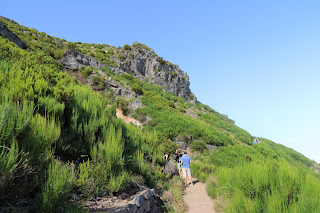fotos ponta de São Lourenço ilha da madeira
A Ponta de São Lourenço é a ponta mais a leste da Madeira e é uma reserve natural com vistas panorâmicas do Oceano Atlântico e de espectaculares formações rochosas; é uma paisagem única muito diferente do resto da ilha.
Se passear a pé poderá encontrar uma variedade de plantas diferentes como a erva gelada (Mesembryanthemum crystallinum), o cardo (Cynara cardunculus), a maçacota (Bassia tomentosa), a perpétua de São Lourenço (Helichrysum devium), o murrião (Helichrysum obconicum) e muitas outras. Descendo a encosta encontrará uma praia isolada chamada Prainha, que é a única praia de areia preta natural da ilha. Muito procurada pelos locais é óptima para banhos de mar.
The Ponta de São Lourenço is the tip further east of Madeira and is a natural reserve with panoramic views of the Atlantic Ocean and spectacular rock formations seen; It is a unique landscape very different from the rest of the island.
If walking you can find a variety of different plants as the icy grass (Mesembryanthemum crystallinum), thistle (Cynara cardunculus), the maçacota (Bassia tomentosa), the life of St. Lawrence (Helichrysum Devium), the murrião (Helichrysum obconicum) and many others. Down the hillside find a secluded beach called Prainha, which is the only natural beach of black sand of the island. Highly sought after by local is great for bathing.
ficha técnica
Percurso: Ponta de Sao Laurenco
Local: Madeira
Partida/Chegada:
Âmbito: Cultural, Paisagístico
Tipo de percurso: Pequena rota, circular
Sinalização:
Pontos de agua:
Distancia percorrida: 8 km
Duração do percurso: 3/4 H
Grau de dificuldade: media/alta
Exposição Solar: extrema
Pontos de Interesse:
IMPORTANTE
Recomendações a considerar em caminhadas
Prestar atenção a dificuldade do percurso indicado. Alguns dos percursos apresentados como pequena rota (PR) como os de grande rota (GR) podem ter alguma dificuldade, ou grandes desníveis, terreno irregulares e rochoso, ou porque ainda inclui etapas perigosas ou difíceis.
Nunca faça percursos sozinho, mas sim de preferência em grupo. Antes de iniciar o percurso avise no seu local de alojamento, em abrigos ou familiares, o itinerário e a hora prevista da viagem. pode deixar, ainda, uma nota sobre o assunto no painel do seu carro, visível do exterior.
Leve roupas adequadas as condições atmosféricas e uma protecção da chuva, pode ser surpreendido a qualquer momento.
Use calcado para caminhadas ou montanhismo (trekking/mountaineering)
No inverno, usando roupas adequadas para ambientes frios.
Leve agua necessária para as condições atmosféricas ja que no verão e no outono poderá falhar. Além disso, a água podera não ser tratada mesmo nas aldeias.
É conveniente levar pastilhas desinfectantes para o caso de falhar a agua que levou.
O nevoeiro e pior inimigo nas montanhas, onde o nevoeiro aparecer subitamente.
Mesmo que conheça a área é melhor procurar um abrigo/refúgio antes que perca a visibilidade.
Em caso de se perder, é melhor procurar um abrigo/refugio mais próximo e esperar por salvamento.
A cobertura telefónica móvel na montanha poderá ser limitada ou mesmo inexistente.
**************************************************************************************
Ter em especial atenção no inverno:
Atenção as marcas de tinta,no inverno a neve pode esconder as marcas
A neve pode bloquear a passagem, especialmente em zonas altas
Com nevoeiro não faça o percurso
Leve agua necessária para as condições atmosféricas
Use calcado para caminhadas ou montanhismo (trekking/mountaineering)
IMPORTANT
Recommendations to consider in hiking
Watch the difficulty of the indicated route. Some of the routes presented as short route (PR) as a major route of the (GR) may have some difficulty, or large gaps, uneven and rocky terrain, or because even includes dangerous or difficult steps.
Never paths alone, but preferably in groups. Before starting the route advise at their place of accommodation, in shelters or family, the route and the estimated time of the trip. You can leave also a note about it in your car's dashboard, visible from the outside.
Take appropriate clothing atmospheric conditions and a rain protection, may be surprised at any time.
Use trampled for hiking or mountain climbing (trekking / mountaineering)
In winter, wearing appropriate clothing for cold environments.
Take the water needed to atmospheric conditions already in the summer and fall may fail. In addition, the water can not be treated in the same villages.
It should take disinfectant tablets for the case of loss of water it took.
The fog and worst enemy in the mountains where the fog suddenly appear.
Even if you know the area is better to seek a shelter / refuge before you lose visibility.
In case you get lost, it is best to seek a shelter / nearest refuge and wait for rescue.
Mobile phone coverage on the mountain may be limited or even nonexistent.
************************************************** ************************************
Pay particular attention in winter:
Attention ink marks in the winter snow can hide marks
Snow can block the passage, especially in high areas
With fog did not make the route
Take the water needed to weather conditions
Use trampled for hiking or mountain climbing (trekking / mountaineering)






















